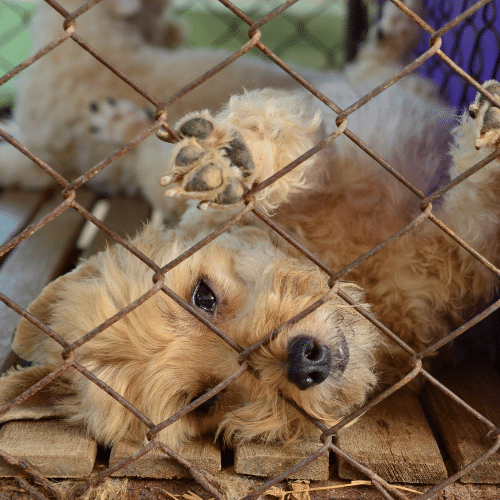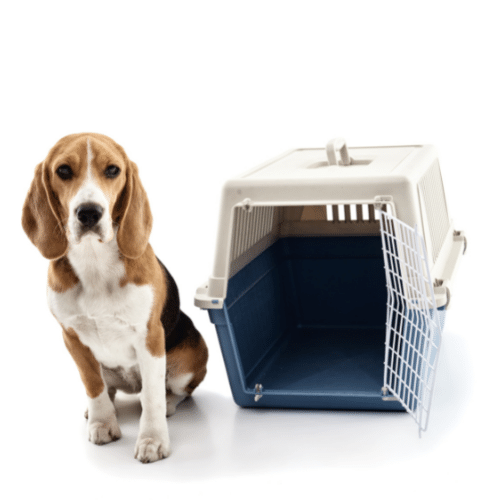Can a Dog Crate Be Too Big?
August 3, 2021 2021-08-03 5:27Crating your dog provides many long-term benefits for both you and your canine companion. If you have a puppy, crating aids in housebreaking and helps your pup feel safe and secure. Older dogs can learn to love their crates and view them as their dens. If crating is done correctly, your dog will not view his crate as punishment or confinement, but rather as an opportunity for restful privacy.
Dogs may choose to enter their crates on their own during periods of stress and overwhelm or simply when they want to have some quiet time alone. The crate should be a peaceful retreat for your dog. He should associate the crate with positive feelings and enjoy being in it.
Never crate your dog for long periods of time, and never use the crate as a way of reprimanding or punishing your dog. If he starts to associate the crate with bad feelings, your crate-training will be less effective and you will have an anxious and likely very vocal dog who thinks he’s being purposely isolated from his family.
But what size crate is the right size? There are so many options to choose from and it can be hard to decide. Many people think that getting the largest crate possible will be best because they assume the dog wants lots of room. In order to allow their dog the most comfort possible, they invest in a crate that is much larger than the dog needs, which can cause more problems in the long run.
Can a dog crate actually be too large for your dog? Absolutely! To avoid the issues that accompany a crate that is not the right size, let’s look at why a crate that is too large will actually be detrimental to crate training your pup.
Table of Contents

If the crate is too big, why does it matter?
If your dog is going to be spending time in a crate, it seems like the nicest thing to do for him would be to allow him the maximum amount of room. This can actually create more anxiety for your dog. When dogs choose their dens in the wild, they select small spaces where they can fit comfortably, but not be exposed much. Just enough room to lie down, stretch out, and sleep comfortably is all that’s necessary. This keeps them hidden from predators, as well. More room means more space and more exposure, while smaller spaces feel safer and more secure.
If you’re crating a puppy, you’re likely using the crate to aid in housebreaking. Dogs don’t like to potty in the same area in which they are sleeping. By crating your puppy, you’re showing him that this is his time for rest. Smaller crates help puppies relax and feel safe. They can feel scared and lonely with too much room and it may take them a long time to settle down. There is another big reason a puppy’s crate should be the proper size. Too much room, and you’ll end up with a puppy that’s using one end of the crate for sleeping and the other end for a potty area!
While he generally won’t potty where he sleeps unless it’s truly an emergency, enough space in the crate will make him feel he can have separate areas for each. This will make housebreaking much harder, because your puppy won’t understand that crate time is time for rest, not potty. If he can go whenever he wants to, he won’t learn to hold it and wait for potty time. It’s best to not give him the option to go when he chooses.

How can I choose the correct crate?
There are so many crate sizes from which to choose and it can be difficult to know which one is the proper one for your dog. When in doubt, measure! When your dog is standing in the crate, his nose and rear end should not be touching each end of the crate.
When sitting or standing in the crate, he should not be hunched or lowering his head down past his shoulder blades. He should be able to fully stand, turn around, and lie down stretched out without being cramped. Measuring helps find the right size crate he’d need to allow for this. With your dog standing, measure the tip of his nose to the base of his tail. You’ll see how long he is with that measurement.
Next, with your dog sitting, measure him from the floor to the top of his ears. This would be the height measurement. Some dogs are taller when they’re sitting as opposed to standing, so it’s best to measure them while they’re sitting to ensure you get a crate that’s comfortable.
With these measurements, you will have a rough idea of the size you’ll need. Take those numbers and add 4-5 inches to each to find the crate size you should be considering. This will ensure your dog can stand, sit, and lie down comfortably in his crate.
Puppies
When it comes to choosing the correct size crate for your puppy, things can be a little different. The measurements you’re taking won’t remain the same as your puppy grows. Buying a crate that is suitable for your puppy when you get him will mean that soon, the crate will become too small. It’s important to never cramp your dog inside a crate, especially as he’s growing. This will lead to health problems down the road. Not to mention – it’s just not nice. Buying new crates for each stage of your puppy’s life is costly and can create an errand that you may not have time to run. Until you purchase a new, larger crate, your puppy is forced to be in one that’s too small. To avoid all of this, there are answers to this problem.
If you have an estimate of how large your puppy will be when he’s fully grown, purchase the right size crate for that measurement, adding 4-5 inches to each number. Then, use crate dividers. These removable dividing panels allow you to adjust them as your dog grows, giving him more space as he requires it. Some crates already come with the dividers, or you can purchase them separately.
Another solution is an expandable crate. You can expand or contract the entire crate depending on how much room your dog requires. This is much easier than having to buy new crates every time your puppy has a growth spurt. It’s also much easier on the wallet. Investing in a crate can be pricey and it’s not something you have to do more than once unless it’s your preference.
How to tell if your dog crate is too big
Sometimes when a crate is too big for a dog, he will seek out other places that make him feel safe. Under a table or bed or behind a couch serve as cozy areas that become your dog’s makeshift den. If he’s feeling uncomfortable in a crate that’s too big, he may seek out these areas. If this behavior is new or accompanied by other signs of illness, a trip to the vet is in order. In a perfectly healthy dog, however, this can simply mean he wants a more secure place to rest.
Notice how your dog rests in the crate. Does he stretch out or mainly keep to one side? Is he using one end of the crate as a potty area? If he’s not utilizing the entire space or worse, using part of the crate as a bathroom, you can tell the crate is too big and your dog doesn’t need all that space. You can measure your dog to find the right size that will work better for him and not waste so much room.

How to tell if your dog crate is too small
If your dog is hunched when standing or sitting in the crate, it’s too small for him. Ideally, your dog should be able to be comfortable in the crate in any position he desires without too much extra space around him. He should be able to stretch out completely, lying on his side.
If you’re going to crate your dog while you’re away during the day or overnight for sleeping, it’s important that he be allowed to be comfortable. He should also be able to turn around completely while standing in the crate. If he can’t do these things, or if his nose and rear end both touch the crate walls while he’s standing, it’s too small.
Some crates (such as especially durable, indestructible crates) can be quite expensive. Please do not skip on size in order to bring down the price. It is not fair to your dog, he needs enough space to comfortably turn around and stand up!
Is it cruel to crate a dog?
Crating your dog helps you housebreak him faster and easier. It prevents your dog from being destructive when you’re not home. If your dog has separation anxiety, a crate can help calm and settle him. An anxious dog left to his own devices can lead to trouble. Chewing, barking, whining, howling, and sometimes injuring himself when you’re not home are all signs your dog is anxious when you’re gone. Rescue dogs can be especially prone to this.
By crating him, you’re giving both yourself and your dog peace of mind. With proper crate training, he will feel safe and calm in the crate. He won’t be able to find ways of acting out his anxiety, and you won’t come home to a mess.
Crating is thought of as cruel when people view it as imprisonment. That’s not what crating is or ever should be. You’re using the crate as a tool to train, protect, and calm your dog. Using a crate improperly can harm your dog emotionally and psychologically.
Punishment
The crate is your dog’s safe space. He should never, ever, feel like he’s being sent to his crate because he did something wrong. This will teach him to associate his safe space with bad feelings. Sending your dog to his crate and locking him in when you’re upset with him for doing something wrong will confuse and scare him. Your dog doesn’t understand why he’s being crated or what’s happening. There are many other ways to train your dog and the right methods don’t include punishing. Crating can become cruel to the dog when it stops being safe in his eyes and becomes something he fears. His safety and security he feels when crated should never be compromised.

Potential Dangers
Proper crate size for your dog is also important to avoid injuries. Inspect your crate to ensure it doesn’t pose a risk to your dog’s safety. Look for sharp edges or corners or places where your dog can get a paw, toe, or ear stuck. Putting a large dog in a crate meant for a small dog will cause injuries because the dog can’t get comfortable. Putting a small dog in a crate meant for a large dog can cause injuries because the dog has more places he can get stuck.
Always take your dog’s collar off before you put him in the crate. A collar, tags, buckles, and the fabric itself can get stuck on the metal bars or latches of the crate and seriously injure him. Don’t allow your dog to be crated while wearing anything, especially something around his neck. Keep the collar close so you can put it back on him when you let him out. Don’t leave it on or near the crate where the dog can be tempted to pull it inside the crate to chew on it. Keeping your dog sage
How long should my dog be in the crate?
A dog cannot do much in a crate besides sleep or rest. He cannot stretch his legs, walk around, sniff or watch out the window. You should only leave your dog in a crate for as long as he will realistically sleep – this is usually 2-3 hours. After that time, he needs to come out and enjoy an enriching activity.
Crating too much and too often can start to affect your dog’s quality of life. Even with frequent breaks, he can become depressed and lonely. If you crate your dog during the day for 8 hours and then again overnight, his mental and emotional well-being can start to suffer. It’s important to not crate your dog any longer than is absolutely necessary. Too much time in isolation can negatively affect your dog’s personality.
The bottom line
Dog crates should always be the right size for your dog. While they can be too small, they can also definitely be too big. When a crate is too big, your dog may start to use part of it as a potty area, which will hinder housebreaking and not teach your dog to hold it.
Your dog should be able to stand up, sit, lie down, and stretch out comfortably in his crate. You can find the exact measurements of the size crate you’ll need by measuring your dog’s length and height and then adding 4 inches to each number.
If your dog’s nose or rear end touch the end of the crate at the same time, the crate is too small. Contrarily, if your dog lies down in one area of the crate only and there is space that isn’t utilized, the crate is too big.
Your dog’s crate should be his den and he should enjoy being in it. Avoid using the crate as a way to punish your dog, as this can cause him to associate the crate with negative feelings and start to fear it. His safe place will then be something he avoids.
No dog should ever be crated longer than 8 hours. If you’re going to be gone longer than this during the day, consider having a dog walker or a friend or family member come to take the dog on a walk and give him a break from being confined. If your dog is crated most of the day and overnight, consider leaving him out of the crate for one of those sessions. He shouldn’t spend most of his time isolated.
Expandable crates and crate dividers are wonderful things in which to invest if you have a puppy that grows to be a much larger size. This way, you can adjust the room in the crate as your dog grows without having to continually buy new crates.
Help keep your dog safe by inspecting the crate for sharp edges or places your dog can get stuck. Always remember to remove your dog’s collar before putting him in the crate.

Author: Jessica Rossetti
Jessica lives in Chicago with her husband, Dominic, and their rescued cat, Toast. She has lived with dogs for over 30 years and spends her days writing, caring for various animals, and enjoying her backyard that has become an oasis for wild creatures.
Her passion for animals began at a young age when she would bring home the lost dog or cat. As she got older, she went on to bring home an injured bird or raccoon. This love and desire to help all creatures led to her work as an adult with various animal rescues, where she saved the lives of many domestic and wild animals while learning the necessary skills to care for them.
Owning and operating a professional pet care service in Chicago for the past twelve years, Jessica cares for dogs in her home while writing full-time.

